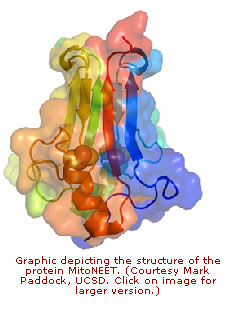

Contents of this Issue:
1. Science Highlight —
Potential Diabetes Drug Target
(contacts: M. Paddock, mpaddock@physics.ucsd.edu; H. Axelrod,
haxelrod@slac.stanford.edu; A. Cohen, acohen@slac.stanford.edu)
 |
2. Science Highlight —
Exploding Beads and Ultrafast Imaging
(contacts: H. Chapman, henry.chapman@llnl.gov; J. Hajdu,
janos@slac.stanford.edu)
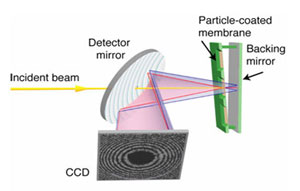 |
3.
Papers Based on Science Performed at SSRL are Awarded
Franšois Farges, Gordon Brown Jr. and co-workers have been awarded the Hawley Medal for their x-ray absorption spectroscopy-based work on the impact of pressure and temperature on structural environments around molybdenum in silicate glasses and melts. The XAS work was performed at SSRL and is described in the paper: The Canadian Mineralogist, 44, 755-773 (2006), which was named the best paper of 2006. The Hawley Medal of the Mineralogical Association of Canada is awarded to the authors of the best paper to appear in The Canadian Mineralogist in a given year. The award is named in honor of Dr. J.E. Hawley (1897-1965) who was distinguished professor of mineralogy at Queen's University.
The Association of Environmental Engineering and Science Professors (AEESP) award has been given for a paper in the journal Science, published in 1987 (Kim F. Hayes, A. Lawrence Roe, Gordon E. Brown Jr., Keith O. Hodgson, James Leckie and George Parks, "In Situ X-ray Absorption Study of Surface Complexes: Selenium Oxyanions on a-FeOOH," Science, 238, 783-786 (1987)). AEESP gives the award "to recognize the authors of a landmark environmental engineering paper that has withstood the test of time and significantly influenced the practice of environmental engineering". The award event took place at the 2007 WEFTEC (Water Environment Federation's Annual Technical Exhibition and Conference).
4.
Information Requested for Reports to SSRL Funding Agencies
It is extremely important that users not only inform us whenever work conducted at SSRL results in a publication, but also acknowledge SSRL and our funding agencies in each publication. User help is needed to keep current records on publications including refereed journal papers, conference proceedings, book chapters and theses, invited lectures and major awards and patents based at least in part on work conducted at SSRL. This information allows SSRL to demonstrate scientific achievements and productivity when responding to requests sent out by the Department of Energy and the National Institutes of Health.
In the near term we will be sending out a request for information for inclusion
in our Annual NIH, NCRR/Biomedical Technology Program (BTP) Progress Report and
in our response to the DOE's request for information for an upcoming peer
review of our facility in January 2008. A direct request will be going out to
our user community, but this information can also be submitted anytime via
email message to Lisa Dunn or Cathy Knotts or via the reference submission form
at:
http://smb.slac.stanford.edu/forms/reporting/form_publication.shtml
For publications lists and the proper acknowledgement statements see:
http://www-ssrl.slac.stanford.edu/pubs/
5.
First Joint SSRL/LCLS Users' Meeting a Success!
(contact: C. Knotts, knotts@slac.stanford.edu)
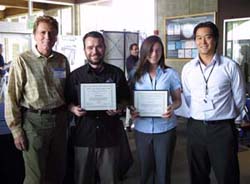 |
Additionally, several graduate students received prizes for outstanding
scientific poster presentations, including: Brittany Nelson-Cheeseman (UC
Berkeley), Origin of Anomalous Magnetic Behavior in
NiMn2O4 Thin Films; Stephen Kelly (Stanford), The Effect
of Cycling on Microstructure and Reaction Kinetics in Mg/MgH2; David
Singer (Stanford), Using Synchrotron Radiation X-ray Techniques to Examine
Uranium Speciation as a Function of Depth in Contaminated Hanford Sediments;
and Samuel Wilson (Stanford), XAS Pre-edge and EXAFS Spectroscopy Reveals
Mechanistic Differences between Tyrosine Hydroxylase and Other Pterin Dependent
Hydroxylases. The event concluded on October 3, 2007, with four concurrent
workshops on 1) XANES Spectroscopy; 2) Microfocusing; 3) Imaging and X-ray
Microscopy; and 4) Scientific Opportunities for Studying Laser Excited Dynamics
at the LCLS.
http://www-conf.slac.stanford.edu/ssrl-lcls/2007/
6.
Cathy Knotts Presented with 2007 Lytle Award
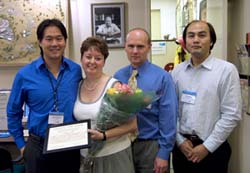 |
7.
Users' Organization Meetings
At the SSRL Users' Organization meeting on October 2, SSRLUOEC Chair Chris Kim
gave a report summarizing the SSRLUOEC's activity for the 2006-2007 year,
thanked the SSRL/LCLS 2007 organizers for an outstanding event, announced that
Yuji Arai and Katherine Kantardjieff had been elected to the SSRLUOEC, and then
turned the baton over to Robert Szilagyi who will chair the SSRLUOEC in
2007/08. Robert summarized the results from the 2007 user survey and solicited
input into questions that could be added to the next survey which is planned
for 2008.
http://www-conf.slac.stanford.edu/ssrl-lcls/2007/slides/CSKim_SSRLUOECtalk.pdf
Mike Lubell, APS Director of Public Affairs and CCNY Professor of Physics, shared his insights into 'Communicating Science for the Public' and summarized communication strategies and possible forums that can aid the dissemination of scientific achievements and research results to non-expert audiences. http://www-conf.slac.stanford.edu/ssrl-lcls/2007/slides/Lubell-SSRLUOEC07.pdf
Following the SSRL Users' Organization Meeting, Jerry Hastings and John Galayda led a discussion of how to organize the LCLS user community and prepare for general user access at the first LCLS experimental station, which is expected to be ready for first light in 2009.
An interim LCLS users' executive committee was formed with the responsibility to draft bylaws for the LCLS Users Organization. The goal is to have these ready to be adopted at the User Workshop in the March-April 2008 where the near term instrument capabilities and schedule will be discussed.
Users interested in learning more about experiments with the LCLS are
encouraged to join the LCLS mailing lists in the areas of: Atomic, Molecular,
and Optical Physics; Femtosecond Dynamics of Molecules; Nanoscale Dynamics of
Condensed Matter; Imaging of Single Nanoparticles and Biomolecules; and/or
Physics of Dense Plasmas and Warm Dense Matter. Additional meetings and
pre-proposal workshops in these focus areas will be organized during 2008.
Register at:
https://oraweb.slac.stanford.edu/apex/slacprod/f?p=173:1:1830939364339841
Kate Beers and Jean Cottam of the Office of Science and Technology Policy (EOP) visited SLAC on Tuesday, October 2, as part of a tour of DOE labs in the Bay Area to learn more about our respective science programs. At SLAC they were given brief overview presentations on SSRL, PULSE, Elementary Particle Physics, Particle Astrophysics and Cosmology and Accelerator Research. The agenda included sitting in on a session of the joint SSRL/LCLS Users' Meeting focusing on LCLS science, a tour of the site, and listening to the Users' Meeting keynote lecture by Roger Kornberg.
On Tuesday, October 23, at 6:30 a.m., an army of production vehicles rolled
through the Main Gate on their way to a full morning of filming at the Stanford
Synchrotron Radiation Laboratory (SSRL). The 40-person crew spent seven hours
capturing images for a video on Stanford's outstanding research institutions.
Having first filmed at BaBar the week before, the crew returned yesterday with
a state-of-the-art high-definition camera to catch researchers in action at
SSRL.
__________________________________________________________________________
SSRL Headlines is published electronically monthly to inform SSRL users,
sponsors and other interested people about happenings at SSRL. SSRL is a
national synchrotron user facility operated by Stanford University for the
U.S. Department of Energy Office of Basic Energy
Sciences. Additional support for
the structural biology program is provided by
the DOE
Office of Biological and Environmental Research, the NIH
National Center for Research Resources and the NIH Institute for General Medical
Sciences. Additional information about
SSRL and its operation and schedules is available from the SSRL WWW
site.
__________________________________________________________________________
To leave the SSRL-HEADLINES distribution, send email as shown below:
To: LISTSERV@SSRL.SLAC.STANFORD.EDU
Subject: (blank, or anything you like)
The message body should read
SIGNOFF SSRL-HEADLINES
That's all it takes. (If we have an old email address for you that is
forwarded to your current address, the system may not recognize who
should be unsubscribed. In that case please write to
ssrl-headlines-request@ssrl.slac.stanford.edu and we'll try to figure out
who you are so that you can be unsubscribed.)
If a colleague would like to subscribe to the list, he or she should send
To: LISTSERV@SSRL.SLAC.STANFORD.EDU and use the message body
SUBSCRIBE SSRL-HEADLINES
9.
Film Crew Visits SLAC
- SLAC Today article by Melinda Lee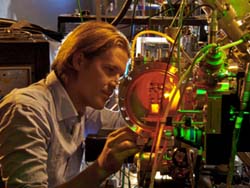
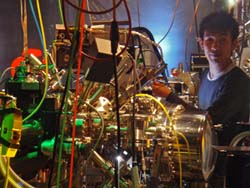
10.
User Administration Update
(contact:
C. Knotts, knotts@slac.stanford.edu)
X-ray/VUV Proposals due November 1: It's not too late to submit a new proposal
for the November 1, 2007 deadline. More information and the forms for
submitting proposals for beam time on SSRL X-ray and VUV beam lines is
available at:
http://www-ssrl.slac.stanford.edu/users/user_admin/xray_vuv_proposal_guide.html
Macromolecular Crystallography Proposals due December 1: If you are interested
in submitting a proposal for the December 1, 2007
deadline for time on
macromolecular crystallography beam lines, see:

http://smb.slac.stanford.edu/public/forms/becominguser/
X-ray/VUV Beam Time Requests: December 7 is the deadline for submitting Beam
Time Requests for the February-May 2008 scheduling period.
http://www-ssrl.slac.stanford.edu/users/user_admin/xray_btrf.html
http://www-ssrl.slac.stanford.edu/users/user_admin/vuv_btrf.html
SSRL/LCLS T-Shirts for Sale: Check in for beam time and check out fall's
hottest look. We have t-shirts for sale this year. Get noticed in our new
SSRL/LCLS-themed t-shirt, available in Texas Orange only. T-Shirt price $10.
See Michelle Steger Bldg. 120, Rm. 219. Don't miss out!!!
SSRL Welcome
Page | Research
Highlights | Beam Lines | Accel
Physics
User
Admin | News & Events |
Safety Office